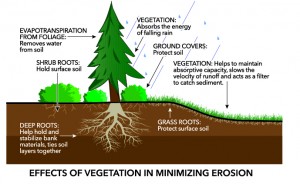 There are times when property owners feel that a tree or several trees should be removed. Unless the tree is a hazard to your life or property, or presents some other major problem, it should be retained whenever possible to keep the soil stabilized. Factors you should consider prior to removal include the stability of the slope, species, age, health, current health of the tree, position of the slope, surrounding vegetation and density of the stand, rooting habit, soil type, and the ability of the tree to sprout after it is cut.
There are times when property owners feel that a tree or several trees should be removed. Unless the tree is a hazard to your life or property, or presents some other major problem, it should be retained whenever possible to keep the soil stabilized. Factors you should consider prior to removal include the stability of the slope, species, age, health, current health of the tree, position of the slope, surrounding vegetation and density of the stand, rooting habit, soil type, and the ability of the tree to sprout after it is cut.
EFFECTS OF VEGETATION IN MINIMIZING EROSION:
- Roots hold surface soil and stabilize bank materials
- Helps the ground to absorb water
- Slows the velocity of runoff and traps sediment
- Absorbs the energy of falling rain
- Removes water from soil and transpires it into the air
For those who live along the water’s edge, trees provide multiple benefits by:
- Reducing stormwater runoff. Trees reduce stormwater runoff by intercepting falling rain in their leafy canopies, slowing the force of rain that falls to the ground. The water is held in the bark and leaves, and absorbed through the roots.
- Reducing risk of erosion. Tree root systems help reduce erosion by holding soil in place. Even after being cut, the roots attached to the stump help stabilize soil for years.
- Reducing risk of landslides. The roots absorb the water in the soil and release it back into the atmosphere through a process called evapotranspiration, removing a significant amount of potentially landslide-causing water in the bluff’s soil.
- Protecting embankments. Fallen trees on the beach protect embankments from wave action. These fallen trees may also serve as “sediment traps”, helping build beaches or provide more buffer at the water’s edge. If branches on fallen trees are in your way, prune them instead of removing the trees.
Trees & shrubs for shoreline & streamside erosion control
| Marine Shore Trees | Marine Shore Shrubs | Stream Trees | Stream Shrubs |
|---|---|---|---|
| Douglas fir | Ocean spray | Douglas fir | Ocean sprey |
| Bigleaf maple | Salal | Bigleaf maple | Red-osier dogwood |
| Madrone | Snowberry | Western red cedar | Red elderberry |
| Western red cedar | Vine maple | Black cottonwood | Sitka alder |
| Willow | Serviceberry | Willow | |
| Shore pine | Oregon grape | Paper birch | |
| Vine maple | Evergreen huckleberry | Bitter cherry | |
| Sitka spruce | Vine maple | ||
| Grand fir | |||
| Cascara |
UNDERSTANDING HOW SHORELINES MOVE: Incoming waves often come ashore in a diagonal direction, with the backwash of the waves flowing perpendicular to the beach. This flow carries sediment in a zigzag pattern along the beach, which is known as littoral drift or shore drift. This movement of sediment is called a drift cell. Areas where sediment is deposited is called a “sink” and can be seen in the form of a beach, spit, hook, bar, or tideflat.